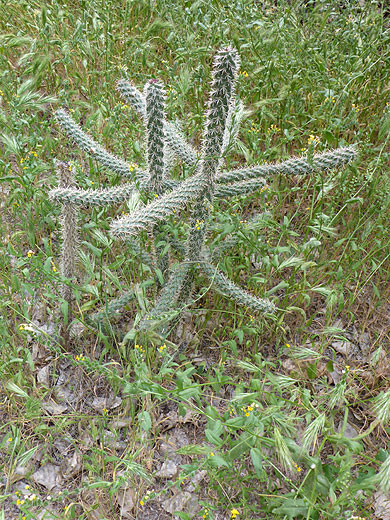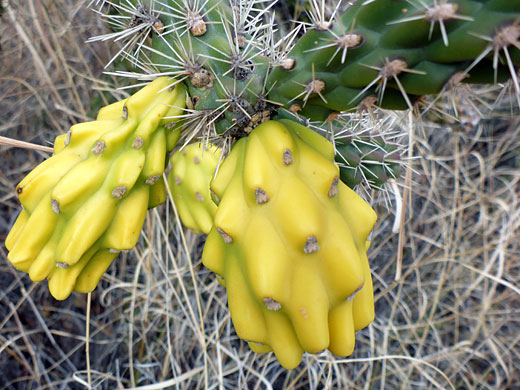Scientific name:
Cylindropuntia spinosior
Common name:
Cane cholla, walking stick cactus
Range:
Central and southeast Arizona, west New Mexico
Form:
Multiple branches from a woody central trunk, more upright than sprawling
Habitat:
Grassland, desert plains, pinyon/juniper woods
Flowers:
Rose purple, occasionally yellow or other colors. Blooming between April and August

Distribution map for cylindropuntia spinosior
Cane cholla has a similar appearance to the buckhorn and staghorn varieties, and overlaps in range, but stems are generally thicker (one inch or more), branch more evenly (at right angles) from more widely separated joints, and tend to droop downwards. Plants are small trees when mature, up to 6 feet tall. Segments have varying lengths between 2 and 20 inches, covered in large, closely spaced tubercles and clusters of 6 to 18 short, whitish spines. The uniform spination makes the plant look smooth and fuzzy from a distance. Like some other cholla, plants turn purple in winter or during dry periods, and the stems become thinner.
Flowers appear during the summer, followed by knobbly, spineless, yellow-green fruit which stay on the plant until the following spring. Tepals are usually bright purple, less often greenish-yellow or reddish. Filaments are purple, anthers pale yellow, and the stigma creamy-white.
Cylindropuntia spinosior is common within its relatively limited range, which extends into north Mexico, and to higher elevations that most other cacti (over 6,500 feet), due to good frost tolerance. The cactus forms hybrids with several other species including cylindropuntia fulgida (jumping cholla), for which the resulting plant is cylindropuntia x kelvinensis. The straight, woody limbs of dead plants have an attractive pattern of holes, and are used to make walking sticks and other items.
Flowers appear during the summer, followed by knobbly, spineless, yellow-green fruit which stay on the plant until the following spring. Tepals are usually bright purple, less often greenish-yellow or reddish. Filaments are purple, anthers pale yellow, and the stigma creamy-white.
Cylindropuntia spinosior is common within its relatively limited range, which extends into north Mexico, and to higher elevations that most other cacti (over 6,500 feet), due to good frost tolerance. The cactus forms hybrids with several other species including cylindropuntia fulgida (jumping cholla), for which the resulting plant is cylindropuntia x kelvinensis. The straight, woody limbs of dead plants have an attractive pattern of holes, and are used to make walking sticks and other items.
All Contents © Copyright The American Southwest | Comments and Questions | Contribute | Affiliate Marketing Disclosure | Site Map







